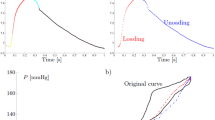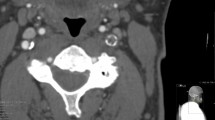Abstract
To perform realistic finite element simulations of cardiovascular surgical procedures (such as balloon angioplasty, stenting or bypass), it is necessary to use appropriate constitutive models able to describe the mechanical behavior of the human arterial wall (in healthy and diseased conditions) as well as to properly calibrate the material parameters involved in such constitutive models. Moving from these considerations, the goal of the present study is to compare the reliability of two isotropic phenomenological models and of four structural invariant-based constitutive models, commonly used to describe the passive mechanical behavior of arteries. The arterial wall is modeled as a thick-wall tube with one- and two- layer structure. Residual stresses inclusion is also considered, to evaluate informations on the stress distribution through the wall thickness. The predictive capability of the investigated models is tested using extension/inflation data on human carotid arteries related by two different experimental works available in the literature. The material parameters involved in the investigated models are computed in the least-square sense thought a best fitting procedure, relying on a multi-start optimization algorithm. The good quality of the optimal solution is validated quantitatively computing proper error measures and comparing the model prediction curves. The final outcome of the paper is a critical review of the six considered constitutive models, comparing their formulation and evidencing the more or less capability of such models to fit the considered experimental data.












Similar content being viewed by others
References
Casscells W, Naghavi M, Willerson JT (2003) Vulnerable atherosclerotic plaque: a multifocal disease. Circulation 107:2072–2075
Chaturvedi S, Bruno A, Feasby T, Holloway R, Benavente O, Cohen S, Cote R, Hess D, Saver J, Spence J, Stern B, Wilterdink J (2005) Carotid endarterectomy—an evidence-based review: report of the therapeutics and technology assessment subcommittee of the american academy of neurology. Neurology 65:794–801
Petersen SPV, Rayner M, Leal J, Luengo-Fernandez R, Gray A (2005) European cardiovascular disease statistics. British Heart Foundation (BHF), London
Cheng GC, Loree HM, Kamm RD, Fishbein MC, Lee RT (1993) Distribution of circumferential stress in ruptured and stable atherosclerotic lesions: a structural analysis with histopathological correlation. Circulation 87:1179–1187
Li Z, Howarth S, Trivedi R, U-King-Im J, Graves M, Brown A, Wang L, Gillard J (2006) Stress analysis of carotid plaque rupture based on in vivo high resolution mri. J Biomech 39:26112622
Kiousis DE, Gasser TC (2007) A numerical model to study the interaction of vascular stents with human atherosclerotic lesions. Ann Biomed Eng 35:1857–1869
Raghavan ML, Vorp DA, Federle MP, Makaroun MS, Webster MW (2000) Wall stress distribution on three dimensionally reconstructed models of human abdominal aortic aneurysm. J Vasc Surg 31:760769
Rodríguez J, Ruiz C, Doblar G, Holzapfel M (2008) Mechanical stresses in abdominal aortic aneurysms: influence of diameter asymmetry and material anisotropy. J Biomech Eng 130:110
Gupta BS, Kasyanov VA (1997) Biomechanics of human common carotid artery and design of novel hybrid textile compliant vascular grafts. J Biomed Mater Res 34:341–349
Lally C, Dolanb F, Prendergast PJ (2005) Cardiovascular stent design and vessel stresses: a finite element analysis. J Biomech 38:1574–1581
Wu W, Qi M, Liu XP, Yang DZ, Wang WQ (2007) Delivery and release of nitinol stent in carotid artery and their interactions: a finite element analysis. J Biomech 40:3034–3040
Gasser TC, Holzapfel GA (2007) Modeling plaque fissuring and dissection during balloon angioplasty intervention. Ann Biomed Eng 35:711–723
Mortier P, Holzapfel GA, De Beule M, Van Loo D, Taeymans Y, Segers P, Verdonck P, Verhegghe B (2010) A novel simulation strategy for stent insertion and deployment in curved coronary bifurcations: comparison of three drug-eluting stents. Ann Biomed Eng 38:88–99
Auricchio F, Conti M, De Beuleb M, De Santisb G, Verheggheb B, Carotid artery stenting simulation:from patient-specific images to finite element analysis. Med Eng Phys. doi:10.1016/j.medengphy.2010.10.011
Humphrey JD (2002) Cardiovascular solid mechanics. Cells, tissue and organs. Springer Verlag, New York
Spencer AJM (1982) Deformation of fiber-reinforced materials. Oxford University Press, Oxford
Spencer AJM (1984) Continuum theory of the mechanics of fibre-reinforced composites. Springer-Verlag, New York
Demiray H (1972) A note on the elasticity of soft biological tissues. J Biomech 5:309–311
Fung YC, Fronek K, Patitucci P (1979) Pseudoelasticity of arteries and the choice of its mathematical expression. Am J Physiol 237:H620–H631
Chuong CJ, Fung YC (1983) Three-dimensional stress distribution in arteries. J Biomech Eng 105:268–274
Takamizawa K, Hayashi K (1987) Strain energy density function and uniform strain hypothesis for arterial mechanics. Biophys J 20:7–17
Fung YC (1993) Biomechanics: mechanical properties of living tissues. Springer Verlag, New York
Ogden RW (1997) Non-linear elastic deformation. Dover, New York
Holzapfel GA, Gasser TC, Ogden RW (2000) A new constitutive framework for arterial wall mechanics and a comparative study of material models. J Elast 61:1–48
Holzapfel GA, Sommer G, Gasser CT, Regitnig P (2005) Determination of layer-specific mechanical properties of human coronary arteries with nonatherosclerotic intimal thickening and related constitutive modeling. Am J Physiol 289:H2048–H2058
Gasser TC, Ogden RW, Holzapfel GA (2006) Hyperelastic modelling of arterial layers with distributed collagen fibre orientations. J R Soc Interface 3:15–35
Baek S, Gleason RL, Rajagopal KR, Humphrey JD (2007) Theory of small on large: potential utility in computations of fluid solid interactions in arteries. Comput Method Appl Mech Eng 196:3070–3078
Pandolfi A, Vasta M (2012) Fiber distributed hyperelastic modeling of biological tissues. Mech Mater 44:151–162; 3070–3078
Hariton I (2007) Vascular biomechanics functional adaptation, anisotropy and seeds of micromechanics. Ph.D. thesis, Ben-Gurion University of the Negev, Beer-Sheva, Israel
Delfino A (1996) Analysis of stress field in a model of the human carotid bifurcation. Ph.D. thesis, Federal Institute of Technology, Lausanne, Switzerland
Hariton G, deBotton I, Gasser TC (2007) Holzapfel, stress-modulated collagen fiber remodeling in a human carotid bifurcation. J Theor Biol 248:460–470
Sommer G, Regitnig P, Költringer L, Holzapfel GA (2010) Biaxial mechanical properties of intact and layer-dissected human carotid arteries at physiological and supra-physiological loadings. Am J Physiol 298:H898–H912
Holzapfel GA, Ogden RW (2009) On planar biaxial tests for anisotropic nonlinearly elastic solids a continuum mechanical framework. Math Mech Solids 14:474–489
Chuong CJ, Fung YC (1986) On residual stress in arteries. J Biomech Eng 108:186–192
Takamizawa K, Hayashi K (1988) Uniform strain hypothesis and thin-walled theory in arterial mechanics. Biorheology 25:555–565
Vaishnav RN, Vossoughi J (1983) Estimation of residual strains in aortic segments. In: Hall CW (ed) Biomedical Engineering. II. Recent Developments. Pergamon, New York, pp 330–333
Greenwald SE, Moore JEJ, Rachev A, Kane TP, Meister JJ (1997) Experimental investigation of the distribution of residual strains in the artery wall. J Biomech Eng 119:438–444
Rachev A (2003) Remodeling of arteries in response to changes in their mechanical environment. In: Holzapfel G, Ogden R (eds) CISM course and lectures 441: biomechanics of soft tissue in cardiovascular systems. Springer-Verlag, Wien, pp 221–271
Holzapfel GA, Gasser TC, Ogden RW (2004) Comparison of a multi-layer structural model for arterial walls with a fung-type model, and issues of material stability. J Biomech Eng 126:264–275
Rhodin JG (1980) Architecture of the vessel wall. In: Bohr DF, Somlyo AD, Sparks HV (eds) Handbook of physiology. The cardiovascular system. Vol 2: vascular smooth muscle. American Physiological Society, Bethesda, pp 1–31
Demiray H, Vito RP (1991) A layered cylindrical shell model for an aorta. J Biomech 5:309311
Wang C, Garsia M, Lu X, Lanir Y, Kassab GS (2006) Three-dimensional mechanical properties of porcine coronary arteries: a validated two-layer model. Am J Physiol 291:H1200–H1209
Holzapfel GA (2000) Nonlinear solid mechanics: a continuum approach for engineering. Wiley, New York
Humphrey JD, Strumpf RK, Yin FCP (1990) Determination of a constitutive relation for passive myocardium: I. a new functional form. J Biomech Eng 112:333–339
Holzapfel GA, Gasser TCSM (2002) A structural model for the viscoelastic behavior of arterial walls: continuum formulation and finite element analysis. Eur J Mech A/Solids 21:441–463
Freed AD, Einstein AD, Vesely I (2005) Invariant formulation for dispersed transverse isotropy in aortic heart valves. An efficient means for modeling fiber splay. Biomech Model Mechanobiol 4:100117
Holzapfel GA, Ogden RW (2010) Constitutive modelling of arteries. Proceedings of the Royal Society A 466:1551–1597
Stålhand J, Klarbring A, Karlsson M (2004) Towards in vivo aorta material identification and stress estimation. Biomech Model Mechanobiol 2:169–186
Stålhand J, Klarbring A (2005) Aorta in vivo parameter identification using an axial force constraint. Biomech Model Mechanobiol 3:191–199
Stålhand J, Klarbring A (2006) Parameter identification in arteries using constraints. In: Holzapfel GA, Ogden RW (eds) Mechanics of biological tissues. Springer, Wien, pp 295–305
Canham PB, Talman EA, Finlay HM (2001) Medial collagen organization in human arteries of the heart and brain by polarized light microscopy. Connect Tissue Res 26:121–134
Finlay HM, McCullough L, Canham PB (1995) Three-dimensional collagen organization of human brain arteries at different transmural pressures. J Vasc Res 32:301–312
Sommer G, Holzapfel GA (2012) 3d constitutive modeling of the biaxial mechanical response of intact and layer-dissected human carotid arteries. J Mech Behav Biomed Mater 5:116128
Sommer G (2008) Mechanical properties of healthy and diseased human arteries. Ph.D. thesis, Graz University of Technology, Institute of Biomechanics
Ogede RW, Saccomandi G, Sgura I (2004) Fitting hyperelastic model to experimental data. Comput Mech 34:484–502
Cortes DH, Lake SP, Kadlowec JA, Elliot DM (2010) Characterizing the mechanical contribution of fiber angular distribution in connective tissue: comparison of two modeling approach. Biomech Model Mechanobiol 9:651658
Wang C, Guo X, Kassab GS (2009) A new observation on the stress distribution in the coronary artery wall. J Biomech Eng. doi:10.1115/1.4000106
Stylianopoulos T, Barocas VH (2007) Multiscale, structure-based modeling for the elastic mechanical behavior of arterial walls. J Biomech 129:611–618
Maceri F, Marino M, Vairo G (2010) A unified multiscale mechanical model for soft collagenous tissues with regular fiber arrangement. J Biomech 43:355–363
Acknowledgments
The support of the Cariplo Foundation through the Project Number n.2009.2822 and the PRIN project n. are gratefully acknowledged.
Author information
Authors and Affiliations
Corresponding author
Rights and permissions
About this article
Cite this article
Auricchio, F., Conti, M. & Ferrara, A. How Constitutive Model Complexity can Affect the Capability to Fit Experimental Data: a Focus on Human Carotid Arteries and Extension/Inflation Data. Arch Computat Methods Eng 21, 273–292 (2014). https://doi.org/10.1007/s11831-014-9105-0
Published:
Issue Date:
DOI: https://doi.org/10.1007/s11831-014-9105-0




